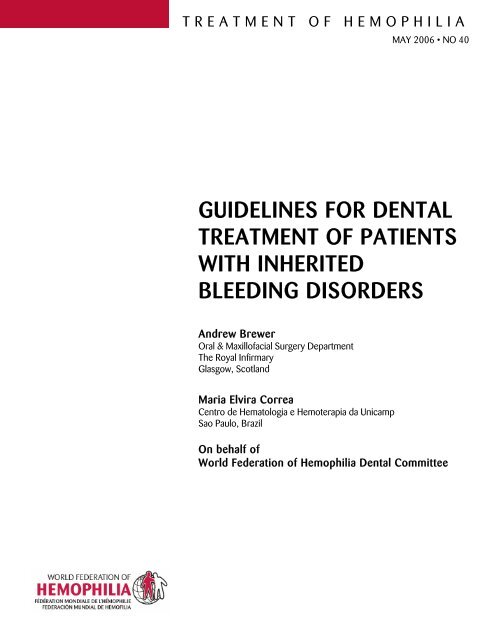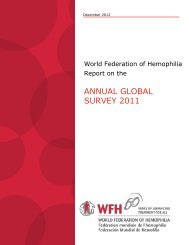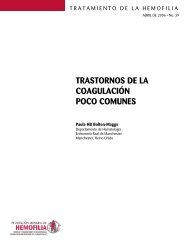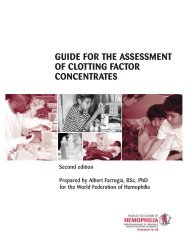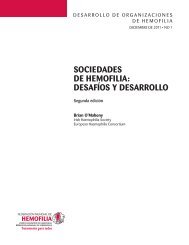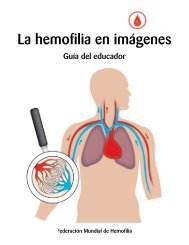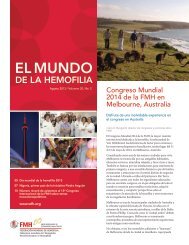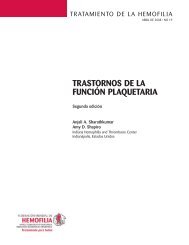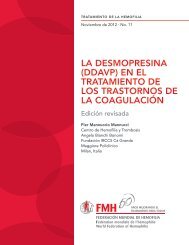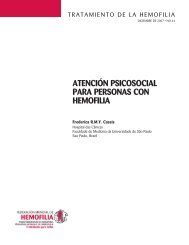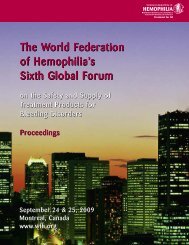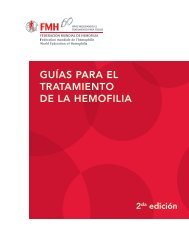Guidelines for Dental Treatment of Patients with Inherited Bleeding ...
Guidelines for Dental Treatment of Patients with Inherited Bleeding ...
Guidelines for Dental Treatment of Patients with Inherited Bleeding ...
You also want an ePaper? Increase the reach of your titles
YUMPU automatically turns print PDFs into web optimized ePapers that Google loves.
TREATMENT OF HEMOPHILIAMAY 2006 • NO 40GUIDELINES FOR DENTALTREATMENT OF PATIENTSWITH INHERITEDBLEEDING DISORDERSAndrew BrewerOral & Maxill<strong>of</strong>acial Surgery DepartmentThe Royal InfirmaryGlasgow, ScotlandMaria Elvira CorreaCentro de Hematologia e Hemoterapia da UnicampSao Paulo, BrazilOn behalf <strong>of</strong>World Federation <strong>of</strong> Hemophilia <strong>Dental</strong> Committee
Published by the World Federation <strong>of</strong> Hemophilia (WFH)© World Federation <strong>of</strong> Hemophilia, 2006The WFH encourages redistribution <strong>of</strong> its publications <strong>for</strong> educational purposes by not-<strong>for</strong>-pr<strong>of</strong>ithemophilia organizations. In order to obtain permission to reprint, redistribute, or translate thispublication, please contact the Communications Department at the address below.This publication is accessible from the World Federation <strong>of</strong> Hemophilia’s web site at www.wfh.org.Additional copies are also available from the WFH at:World Federation <strong>of</strong> Hemophilia1425 René Lévesque Boulevard West, Suite 1010Montréal, Québec H3G 1T7CANADATel. : (514) 875-7944Fax : (514) 875-8916E-mail: wfh@wfh.orgInternet: www.wfh.orgThe <strong>Treatment</strong> <strong>of</strong> Hemophilia series is intended to provide general in<strong>for</strong>mation on the treatment andmanagement <strong>of</strong> hemophilia. The World Federation <strong>of</strong> Hemophilia does not engage in the practice <strong>of</strong>medicine and under no circumstances recommends particular treatment <strong>for</strong> specific individuals. Doseschedules and other treatment regimes are continually revised and new side effects recognized. WFHmakes no representation, express or implied, that drug doses or other treatment recommendations in thispublication are correct. For these reasons it is strongly recommended that individuals seek the advice <strong>of</strong> amedical adviser and/or to consult printed instructions provided by the pharmaceutical company be<strong>for</strong>eadministering any <strong>of</strong> the drugs referred to in this monograph.Statements and opinions expressed here do not necessarily represent the opinions, policies, orrecommendations <strong>of</strong> the World Federation <strong>of</strong> Hemophilia, its Executive Committee, or its staff.<strong>Treatment</strong> <strong>of</strong> Hemophilia MonographsSeries EditorDr. Sam SchulmanAcknowledgementsThe WFH is grateful to members <strong>of</strong> the WFH <strong>Dental</strong> Committee <strong>for</strong> their work in developing theseguidelines. Thanks also to Dr Richard A. Lipton and Barbara McDonald <strong>for</strong> their help.Series editor’s noteThe monograph adds to two previous WFH monographs on oral and dental care, prophylaxis andtreatment (<strong>Treatment</strong> <strong>of</strong> Hemophilia Monographs No. 3 and 27). It is written by dentists <strong>for</strong> dentists anddoes not provide specific guidelines regarding doses <strong>of</strong> factor concentrates. Details on that and resultsfrom a decade <strong>of</strong> treatments and oral surgical procedures have been published by Franchini et at(Haemophilia 2005;11:504-9) and may be helpful to read <strong>for</strong> the hematologist involved in the team.
Table <strong>of</strong> ContentsForeword..................................................................................................................................................................... 1Introduction................................................................................................................................................................ 1Minimizing the use <strong>of</strong> clotting factor concentrates............................................................................................... 1Prevention................................................................................................................................................................... 2<strong>Dental</strong> treatment ........................................................................................................................................................ 3Periodontal treatment ............................................................................................................................................... 3Removable prosthodontics....................................................................................................................................... 3Orthodontic treatment .............................................................................................................................................. 3Restorative procedures ............................................................................................................................................. 3Endodontics.................................................................................................................................................. 4Anesthesia and pain management .......................................................................................................................... 4Surgery ........................................................................................................................................................................ 41. <strong>Treatment</strong> plan......................................................................................................................................... 42. Pre-operative period ............................................................................................................................... 53. Peri-operative period .............................................................................................................................. 54. Post-operative period.............................................................................................................................. 5Post-extraction hemorrhage ..................................................................................................................................... 5Fibrin glue .................................................................................................................................................... 6Splints............................................................................................................................................................ 6Management <strong>of</strong> oral infections ................................................................................................................................ 61. <strong>Dental</strong> infections...................................................................................................................................... 62. Periodontal infection................................................................................................................................73. Topical treatment..................................................................................................................................... 7<strong>Dental</strong> emergencies ................................................................................................................................................... 7Conclusion.................................................................................................................................................................. 7References ................................................................................................................................................................... 8
<strong>Guidelines</strong> <strong>for</strong> <strong>Dental</strong> <strong>Treatment</strong> <strong>of</strong> <strong>Patients</strong> <strong>with</strong><strong>Inherited</strong> <strong>Bleeding</strong> Disorders<strong>Dental</strong> Committee, World Federation <strong>of</strong> HemophiliaForewordThe dental treatment <strong>of</strong> patients <strong>with</strong> inheritedbleeding disorders has been widely discussed inthe literature <strong>with</strong> the aim <strong>of</strong> developingguidelines <strong>for</strong> common procedures. Themajority <strong>of</strong> guidelines recommend the use <strong>of</strong>clotting factor replacement therapy be<strong>for</strong>einvasive oral surgery and the use <strong>of</strong> the inferioralveolar nerve block <strong>for</strong> restorative dentaltreatment. The dose <strong>of</strong> clotting factor used variesand this may be due to problems relating to boththe availability and cost <strong>of</strong> factor concentrates indifferent parts <strong>of</strong> the world.Successful protocols are the result <strong>of</strong>cooperation between hematologists and dentists.These protocols suggest the use <strong>of</strong> factorconcentrate along <strong>with</strong> the use <strong>of</strong> localhemostatic techniques, such as suturing, andlocal measures, such as the use <strong>of</strong> oxidizedcellulose, <strong>for</strong> example Surgicel ® or fibrin glue inconjunction <strong>with</strong> post-operatively administeredantifibrinolytic agents where appropriate. Theuse <strong>of</strong> local techniques has resulted in certainminor oral surgery procedures being done <strong>with</strong>minimal or no coagulation factor replacement.The purpose <strong>of</strong> these guidelines is to provide abasis <strong>for</strong> the development <strong>of</strong> local protocols <strong>for</strong>the dental treatment <strong>of</strong> patients <strong>with</strong> inheritedbleeding disorders.IntroductionHemophilia is an X-linked hereditary disorder.Hemophilia A is a deficiency <strong>of</strong> factor VIII andhemophilia B (Christmas disease) is a deficiency<strong>of</strong> factor IX. Hemophilia is considered severewhen plasma activity is
2 <strong>Guidelines</strong> <strong>for</strong> <strong>Dental</strong> <strong>Treatment</strong> <strong>of</strong> <strong>Patients</strong> <strong>with</strong> <strong>Inherited</strong> <strong>Bleeding</strong> Disordersprovide guidelines that allow dental treatmentto be carried out safely whilst minimizing theuse <strong>of</strong> factor concentrates.Historically, international guidelines <strong>for</strong> oralsurgery recommended the administration <strong>of</strong>clotting factor concentrates both be<strong>for</strong>e and aftersurgery. Doses are calculated to increase thelevel <strong>of</strong> factor VIII or IX to 50-100 IU/dL <strong>for</strong> aperiod <strong>of</strong> at least seven days [9,10]. Ublansky etal. [11] advised an increase <strong>of</strong> factor VIII or IX to50% <strong>for</strong> either regional or infiltration localanesthesia.The literature describes many successful dentaltreatment protocols that provide a remarkablereduction in the number <strong>of</strong> bleeding episodesfollowing oral procedures using oralantifibrinolytic agents, systemic hemostaticreplacement therapy, and local hemostaticagents [12-17].In a WFH monograph by Harrington [18], lowerdoses (30% <strong>of</strong> normal) <strong>of</strong> clotting factorconcentrates are recommended <strong>for</strong> infiltrationanesthesia <strong>of</strong> the lower jaw and periodontalcurettage. For more invasive surgicalinterventions, the recommendation is to increasethe factor level from 50-100 IU/dL <strong>of</strong> normalpre-operatively, and use an oral antifibrinolyticagent pre- and post-operatively.Sindet-Pedersen [15,17] suggests that the dose <strong>of</strong>factor replacement therapy can be significantlyreduced if used <strong>with</strong> an oral rinse <strong>of</strong> anantifibrinolytic agent (tranexamic acid) is usedfollowing a dental extraction. He recommends asingle dose <strong>of</strong> factor, in cases <strong>of</strong> severehemophilia A elevating the factor VIII level to10IU/dL. Desmopressin, a synthetic derivative<strong>of</strong> the hormone vasopressin, has been shown toincrease factor VIII level in some patients <strong>with</strong>mild or moderate <strong>for</strong>ms <strong>of</strong> hemophilia A or type1 von Willebrand disease. Un<strong>for</strong>tunately, not allpatients respond so this should be checkedbe<strong>for</strong>e per<strong>for</strong>ming any surgical procedure. Itsuse is well documented in cases <strong>of</strong> mild andmoderate hemophilia A [19-21]. DDAVPreleases bound factor VIII and is there<strong>for</strong>e notused to treat patients <strong>with</strong> hemophilia B. Areport by Ehl et al. [22] showing a clinicalresponse to desmopressin in four patients <strong>with</strong>hemophilia B <strong>with</strong> baseline factor IX levels <strong>of</strong> 1.4to 5% <strong>for</strong> oral surgery. They report a reductionin the use <strong>for</strong> plasma products followingtreatment.Fibrin glue is used as a local hemostatic measurein some centres <strong>for</strong> achieving hemostasis andreducing the needs <strong>for</strong> clotting factorreplacement therapy (see section on page 6).PreventionThe prevention <strong>of</strong> dental problems is anessential component <strong>of</strong> oral care. A successfulregimen will reduce the need <strong>for</strong> treatment andshould reduce the number <strong>of</strong> emergency visits.<strong>Dental</strong> prevention depends on a number <strong>of</strong>different factors. Some <strong>of</strong> these may not beavailable in developing countries but areincluded to demonstrate the ideal situation.• Brushing twice daily <strong>with</strong> a fluoridetoothpaste.- 1,000-ppm fluoride toothpaste <strong>for</strong>children under 7 years <strong>of</strong> age.- 1,400-ppm fluoride toothpaste <strong>for</strong>people over 7 years <strong>of</strong> age.The use <strong>of</strong> fluoride toothpaste depends onthe fluoride concentration in the watersupply as well as the use <strong>of</strong> additionalfluoride supplements. It should not be usedif fluoride supplements are taken or if thewater supply has a fluoride content <strong>of</strong> 1ppm or more.• The toothbrush should have mediumtexture bristles because hard bristles cancause abrasion <strong>of</strong> the teeth and s<strong>of</strong>t bristlesare inadequate to remove plaque.• Interdental cleaning aids, such as floss, tape,and interdental brushes, should be used toprevent the <strong>for</strong>mation <strong>of</strong> dental caries andperiodontal disease.• Fluoride supplements may be used, but arenot recommended if the water supply has afluoride content <strong>of</strong> 1 ppm or more.Supplements include:- Fluoride drops- Fluoride tablets- Topical application <strong>of</strong> fluoride usingtrays- Fluoride mouthrinses which can be usedon either a daily or a weekly basis.
<strong>Guidelines</strong> <strong>for</strong> <strong>Dental</strong> <strong>Treatment</strong> <strong>of</strong> <strong>Patients</strong> <strong>with</strong> <strong>Inherited</strong> <strong>Bleeding</strong> Disorders 3• The consumption <strong>of</strong> foods and drinks <strong>with</strong> ahigh sugar or acid content should be limitedto mealtimes. Three exposures per day is therecommended maximum. The aim is toensure that the intake <strong>of</strong> food and drinkdoes not cause the pH <strong>of</strong> the oral cavity t<strong>of</strong>all below the critical level <strong>of</strong> pH 5.5.• Artificial sweeteners can be used as analternative to sugars in food and drinks.Examples are aspartame, sorbitol,acesulfamate, etc.• Regular dental visits, usually every 6months, will help identify problems early,rein<strong>for</strong>ce prevention, and emphasize theimportance <strong>of</strong> reducing the intake <strong>of</strong> foodand drink containing high levels <strong>of</strong> sugar oracid.The Scottish Intercollegiate Guideline Networkhas published Preventing <strong>Dental</strong> Caries inChildren at High Risk, which includes a quickreference guide, may also be a useful resource[23]. It is available from their website athttp://www.sign.ac.uk/pdf/sign47.pdf.<strong>Dental</strong> treatmentIt is essential to prevent accidental damage to theoral mucosa when carrying out any procedure inthe mouth. Injury can be avoided by:Careful use <strong>of</strong> saliva ejectors;Careful removal <strong>of</strong> impressions;Care in the placement <strong>of</strong> X-ray films,particularly in the sublingual region;Protection <strong>of</strong> s<strong>of</strong>t tissues during restorativetreatment by using a rubber dam or applyingyellow s<strong>of</strong>t paraffin (vaseline ® ).blood loss. In addition, chlorhexidine gluconatemouthwash can be used to control periodontalproblems. Antibiotics may be required to helpreduce the initial inflammation.Blood loss <strong>of</strong> all kinds can be controlled locally<strong>with</strong> direct pressure or periodontal dressings<strong>with</strong> or <strong>with</strong>out topical antifibrinolytic agents.Periodontal surgery in patients <strong>with</strong> bleedingdisorders must always be regarded as a highriskprocedure <strong>with</strong> a significant risk <strong>of</strong> bloodloss. It should only be considered wereconservative treatment has failed and oralhygiene is good. Periodontal surgery can be agreater challenge to hemostasis than a simpleextraction. The procedure must be carefullyplanned and the risks fully explained to thepatient.Removable prosthodontics<strong>Patients</strong> <strong>with</strong> bleeding disorders can be givendentures as long as they are com<strong>for</strong>table. If apartial denture is provided it is important thatthe periodontal health <strong>of</strong> the remaining teeth ismaintained.Orthodontic treatmentFixed and removable orthodontic appliancesmay be used along <strong>with</strong> regular preventiveadvice and hygiene therapy. Special care shouldbe taken when treating patients <strong>with</strong> a severebleeding disorder to ensure that the gingiva isnot damaged when fitting the appliance.Periodontal treatmentHealthy periodontal tissue is essential to preventbleeding and tooth loss. If oral hygiene is poortreatment must start as soon as possible after thepatient has had a dental examination andtreatment plan <strong>for</strong>mulated to prevent additionaldamage to the periodontal tissues. In cases <strong>of</strong>severe periodontal disease, it may be necessaryto carry out supragingival scaling initially along<strong>with</strong> oral hygiene education. Subgingival scalingcan start as soon as the inflammation hasdecreased. The treatment may need to be carriedout over several visits to prevent excessiveRestorative proceduresRestorative treatment can be undertakenroutinely providing care is taken to protect themucosa. There is a risk <strong>of</strong> bleeding <strong>with</strong> the use<strong>of</strong> matrix bands or wooden wedges. This can becontrolled by local means or the application <strong>of</strong>topical agents. The risks <strong>of</strong> using localanesthetics and the requirement <strong>for</strong> prophylaxisare discussed in a later section.
4 <strong>Guidelines</strong> <strong>for</strong> <strong>Dental</strong> <strong>Treatment</strong> <strong>of</strong> <strong>Patients</strong> <strong>with</strong> <strong>Inherited</strong> <strong>Bleeding</strong> DisordersEndodonticsEndodontic treatment is generally low risk <strong>for</strong>patients <strong>with</strong> bleeding disorders. If apulpectomy is indicated, the possibility <strong>of</strong> thetooth requiring conventional endodontictreatment must also be considered. It isimportant that the procedure be carried outcarefully <strong>with</strong> the working length <strong>of</strong> the rootcanal calculated to ensure that the instrumentsdo not pass through the apex <strong>of</strong> the root canal.The presence <strong>of</strong> bleeding in the canal isindicative <strong>of</strong> pulp tissue remaining in the canal.Sodium hypochlorite should be used <strong>for</strong>irrigation in all cases, followed by the use <strong>of</strong>calcium hydroxide paste to control the bleeding.Formaldehyde-derived substances may also beused in cases where there is persistent bleedingor even be<strong>for</strong>e the pulpectomy.Anesthesia and pain management<strong>Dental</strong> pain can usually be controlled <strong>with</strong> aminor analgesic such as paracetamol(acetaminophen). Aspirin should not be useddue to its inhibitory affect on plateletaggregation. The use <strong>of</strong> any non-steroidal antiinflammatorydrug (NSAID) must be discussedbe<strong>for</strong>ehand <strong>with</strong> the patient's hematologistbecause <strong>of</strong> their effect on platelet aggregation.There are no restrictions regarding the type <strong>of</strong>local anesthetic agent used although those <strong>with</strong>vasoconstrictors may provide additional localhemostasis. It is important to advise patientsand parents <strong>of</strong> children about the risks <strong>of</strong> localoral trauma be<strong>for</strong>e the anesthetic wears <strong>of</strong>f.A buccal infiltration can be used <strong>with</strong>out anyfactor replacement. It will anesthetize all theupper teeth and lower anterior and premolarteeth.The mandibular molar teeth are usually treatedusing the inferior alveolar nerve block. Thisshould only be given after raising clotting factorlevels by appropriate replacement therapy, asthere is a risk <strong>of</strong> bleeding into the muscles along<strong>with</strong> potential airway compromise due to ahematoma in the retromolar or pterygoid space.The intraligamental technique or interosseoustechnique should be considered instead <strong>of</strong> themandibular block. Articaine ® has been used as abuccal infiltration to anesthetize the lower molarteeth. A lingual infiltration also requiresappropriate factor replacement since theinjection is into an area <strong>with</strong> a rich plexus <strong>of</strong>blood vessels and the needle is not adjacent tobone. There is a risk <strong>of</strong> a significant airwayobstruction in the event a bleed [24].LOCAL ANESTHETIC TECHNIQUESNO HEMOSTATICCOVER REQUIREDBuccal infiltrationIntra-papillary injectionsIntraligamentaryinjectionsSurgeryHEMOSTATICCOVERREQUIREDInferior dental blockLingual infiltrationSurgical treatment, including a simple dentalextraction, must be planned to minimize the risk<strong>of</strong> bleeding, excessive bruising, or hematoma<strong>for</strong>mation. The following points will helpprevent problems:Emergency surgical intervention in dentistry israrely required as pain can <strong>of</strong>ten be controlled<strong>with</strong>out resorting to an unplanned treatment.All treatment plans must be discussed <strong>with</strong> thehemophilia unit if they involve the use <strong>of</strong>prophylactic cover.1. <strong>Treatment</strong> planThe treatment plan should be <strong>for</strong>mulated usingthe following guidelines:• Conduct a thorough clinical andradiographic examination.• Identify which treatment may requireprophylactic cover. If multiple extractionsare required, only one or two teeth shouldbe extracted at the first appointment toensure that hemostasis can be achieved. It isimportant to remember the patient’s socialcircumstances (Do they live alone? What aretheir preferences <strong>for</strong> treatment) as well asthe clinical condition when making thisdecision.• Observe all patients <strong>for</strong> a prolonged periodafter a dental extraction. This may be <strong>for</strong> a few
<strong>Guidelines</strong> <strong>for</strong> <strong>Dental</strong> <strong>Treatment</strong> <strong>of</strong> <strong>Patients</strong> <strong>with</strong> <strong>Inherited</strong> <strong>Bleeding</strong> Disorders 5hours <strong>for</strong> those patients <strong>with</strong> a mild bleedingtendency whilst those <strong>with</strong> more severeconditions or a history <strong>of</strong> prolonged bleedingdespite hemostatic cover may requiresupervision overnight in hospital. [25]• Discuss treatment requiring theadministration <strong>of</strong> coagulation factor ordesmopressin (DDAVP) <strong>with</strong> thehemophilia unit. They will be responsible<strong>for</strong> arranging the administration andmonitoring <strong>of</strong> treatment products.• Discuss the use <strong>of</strong> local hemostatic agents.This could include the use <strong>of</strong> oxidizedcellulose (Surgicel ® ) or fibrin glue. Fibringlue should not normally be used in patientswho have never received human-derivedblood products or those who are receivingtreatment <strong>with</strong> recombinant factor VIII or IXbecause <strong>of</strong> the potential risks <strong>of</strong> human viraltransmission.• Consider whether to use antibioticsfollowing a dental extraction. This iscontroversial, but there are a number <strong>of</strong>anecdotal reports suggesting that their usemay prevent a late bleed, which is thoughtto be due to infection. However, if a patienthas an infection be<strong>for</strong>e treatment, it shouldbe treated <strong>with</strong> antibiotics.• Always carry out treatment asatraumatically as possible.2. Pre-operative period• Ensure that the oral cavity is as healthy aspossible be<strong>for</strong>e any surgical procedure. Thiscan be achieved by arranging treatment<strong>with</strong> a hygienist to remove as much calculusand plaque as possible. The regular use <strong>of</strong>an antibacterial mouthwash, <strong>for</strong> examplechlorhexidine, may also help.• Consider using an antifibrinolytic agent. Itmay be helpful to start the treatment the daybe<strong>for</strong>e the surgery. Tranexamic acid (usualadult dose 1 g three times a day) and epsilonaminocaproic acid (EACA) (50 mg/kg fourtimes a day), are the most commonly useddrugs. They should be continued <strong>for</strong> a total<strong>of</strong> 7 days.3. Peri-operative period• Have the patient rinse <strong>with</strong> chlorhexidinemouthwash <strong>for</strong> 2 minutes be<strong>for</strong>e theadministration <strong>of</strong> the local anesthetic.• Carry out the extraction out asatraumatically as possible.• Suture the socket if the gingival margins donot oppose well. Brewer [26] reports a smallseries where sutures were not usedroutinely and there was no significantincrease in post-extraction hemorrhage.Resorbable and non-resorbable sutures maybe used at the operator’s discretion. Theonly problem <strong>with</strong> non-resorbable sutures isthe need <strong>for</strong> a post-operative visit and thepossibility <strong>of</strong> bleeding when the suture isremoved.• Use local hemostatic measures if indicated.These include the use <strong>of</strong> oxidized celluloseor fibrin glue (see notes on the use <strong>of</strong> fibringlue).• Use a s<strong>of</strong>t vacuum <strong>for</strong>med splint to protectthe socket if needed.4. Post-operative periodThe patient must be given detailed postoperativeinstructions:• No mouth rinsing <strong>for</strong> 24 hours;• No smoking <strong>for</strong> 24 hours;• S<strong>of</strong>t diet <strong>for</strong> 24 hours;• No strenuous activities <strong>for</strong> 24 hours;• Prescribed medication must be taken asinstructed;• Analgesia should be prescribed <strong>for</strong> use ifrequired;• Salt-water mouthwashes (1 teaspoon <strong>of</strong> saltin a glass <strong>of</strong> warm water) should be usedfour times a day starting the day after theextraction <strong>for</strong> 7 days [27];• Antibacterial mouthwash may be used;• Emergency contact details must be given tothe patient in case <strong>of</strong> problems.Post-extraction hemorrhageCareful pre-operative planning and the use <strong>of</strong>antifibrinolytic agents will prevent many postoperativeproblems [28]. However, postextractionbleeding will occur on occasion. Ifpost-extraction hemorrhage occurs:Contact the hemophilia unit and consider usingadditional factor concentrate.Inspect the site <strong>of</strong> the bleed. If there is anyevidence <strong>of</strong> a tear in the gingiva or otherobvious bleeding point this should be treatedusing local measures as previously described.
6 <strong>Guidelines</strong> <strong>for</strong> <strong>Dental</strong> <strong>Treatment</strong> <strong>of</strong> <strong>Patients</strong> <strong>with</strong> <strong>Inherited</strong> <strong>Bleeding</strong> DisordersInstruct the patient to sit up and bite on a dampgauze swab <strong>for</strong> at least 10 minutes.Use a 10% solution <strong>of</strong> tranexamic acid or EACAto dampen the swab or as a mouthwash if thebleeding is difficult to stop.Monitor the patient’s blood pressure as it mayincrease due to worry and pain. If the patienthas pain, a suitable analgesic should beprescribed whilst if there is no pain a small dose<strong>of</strong> a benzodiazepine or similar will help toreduce the worry and reduce the blood pressure.Fibrin glueIn some hemophilia centres, fibrin glue is usedas a local hemostatic measure, along <strong>with</strong> anoral antifibrinolytic agent, to achieve hemostasisand reduce the need <strong>for</strong> clotting factorreplacement therapy. All fibrin glue containshuman or animal components, which has madea number <strong>of</strong> physicians and patients beinghesitant to use this treatment particularly <strong>for</strong>patients who are receiving recombinant factorconcentrates or have never received bloodproducts derived from humans.Fibrin glue mimics the final pathway <strong>of</strong>coagulation cascade at the point wherefibrinogen is converted into fibrin in thepresence <strong>of</strong> thrombin, factor XIII, fibronectin,and ionized calcium. The cascade reactionprovokes the cleavage <strong>of</strong> fibrinogen throughthrombin, <strong>for</strong>ming fibrin peptides A and B fromeach molecule <strong>of</strong> fibrinogen resulting in the<strong>for</strong>mation <strong>of</strong> the fibrin monomers. Thrombinitself also activates factor XIII, which in thepresence <strong>of</strong> calcium permits the stabilization <strong>of</strong>the clot. Fibronectin takes part in the process aswell and its inclusion in the adhesive systemappears to promote cellular migration and theactivation <strong>of</strong> fibroblasts in the area where thefibrin glue was applied [29-32].SplintsS<strong>of</strong>t vacuum-<strong>for</strong>med splints can be used toprovide local protection following a dentalextraction or prolonged post-extraction bleed.The following technique is used to construct thesplint pre-operatively:• Take a dental impression be<strong>for</strong>e theextraction and cast a model in thelaboratory.• Remove the tooth being extracted from themodel.• Construct a s<strong>of</strong>t vacuum-<strong>for</strong>med splint tocover the socket completely.• Keep the splint in place <strong>for</strong> at least 48 hoursbe<strong>for</strong>e checking the socket. If there is anysign <strong>of</strong> bleeding it should be replaced andchecked every 24 hours.If the splint is to be used to stop a postextractionhemorrhage, the impression must bethoroughly cleaned and disinfected be<strong>for</strong>e it istransported to the laboratory.Management <strong>of</strong> oral infections<strong>Dental</strong> infectionsMany patients <strong>with</strong> infections <strong>of</strong> dental originare managed <strong>with</strong>out the use <strong>of</strong> antibiotics butinstead by dental extraction or endodontictreatment, <strong>for</strong> example [33].Antibiotics are <strong>of</strong>ten used to treat an acutebacterial infection. This should be considered <strong>for</strong>all patients <strong>with</strong> inherited bleeding disorderssince surgical intervention should be avoided ifpossible. The initial treatment usually startsbased on the normal oral pathogens,Streptococcus viridans, anaerobic gram-positivecocci and anaerobic gram-negative rods.Antibiotic regimes should cover all <strong>of</strong> thesegroups <strong>of</strong> organisms [34].Penicillin is a first-line antibiotic used to treatdental infections. It can be taken orally in the<strong>for</strong>m <strong>of</strong> penicillin V. Metronidazole is extremelyeffective in treating anaerobes and is <strong>of</strong>ten usedin combination <strong>with</strong> penicillin to give goodcoverage <strong>of</strong> both the aerobic and anaerobicbacteria present in the oral cavity. The doses <strong>of</strong>the drugs may vary depending on theavailability in different countries but thetreatment should continue <strong>for</strong> 5–7 days.A number <strong>of</strong> different <strong>for</strong>mulations <strong>of</strong> penicillinare available <strong>with</strong> a broader spectrum <strong>of</strong>activity. These can be used either alone or inconjunction <strong>with</strong> metronidazole. However, itisimportant to remember that if these drugs areineffective treatment <strong>of</strong> the infection willbecome more complicated.Erythromycin and clindamycin have beenprescribed to patients who are allergic topenicillin [33]. These drugs can be used in
<strong>Guidelines</strong> <strong>for</strong> <strong>Dental</strong> <strong>Treatment</strong> <strong>of</strong> <strong>Patients</strong> <strong>with</strong> <strong>Inherited</strong> <strong>Bleeding</strong> Disorders 7conjunction <strong>with</strong> metronidazole. Erythromycinmay be effective in people <strong>with</strong> penicillinallergies, but it may not be suitable <strong>for</strong> moresevere infections [34].Clindamycin produces high alveolarconcentrations [35], and bactericidal activity isreached <strong>with</strong> the usual recommended oral dose<strong>of</strong> 150 mg every 6 hours. In more severe cases itcan be given intravenously. It has been reportedthat clindamycin can cause antibiotic-associatedcolitis and there<strong>for</strong>e is <strong>of</strong>ten reserved <strong>for</strong> thetreatment <strong>of</strong> the more serious infections or whenpenicillin has failed [33,34].Periodontal infectionPeriodontal pockets host a variety <strong>of</strong> differentbacteria, the majority <strong>of</strong> them being anaerobic.Regular oral hygiene prevents these bacteriafrom causing gingival inflammation.In patients <strong>with</strong> severe gingival inflammation, inparticular those who are immune compromised,the use <strong>of</strong> an antimicrobial agent may beindicated. Metronidazole is considered the drug<strong>of</strong> choice due to its action against anaerobicorganisms. It may be used in conjunction <strong>with</strong>either penicillin or erythromycin. However,antimicrobial therapy is no substitute <strong>for</strong> oralhygiene treatment.Topical treatmentThe most common <strong>for</strong>ms <strong>of</strong> topical treatmentinvolve the use <strong>of</strong> an antibacterial mouthwash.These have value as an adjunct to hygiene phasetreatment. The most common treatments are:• Chlorhexidine gluconate: Chlorhexidine isavailable as a mouthwash, spray, andtoothgel. It is most commonly used as atwice a day mouthwash <strong>with</strong> the patientrinsing their mouth <strong>with</strong> the solution <strong>for</strong> 30–60 seconds. The toothgel may be used inaddition to the mouthwash. chlorhexidinehas a tendency to stain teeth so the length <strong>of</strong>each course <strong>of</strong> treatment should be limited.• Povidine-iodine: povidine-iodine isavailable as a mouthwash and can be used<strong>for</strong> the treatment <strong>of</strong> acute periodontalproblems. In addition, it may be useful toirrigate the periodontal pockets. It must beused <strong>with</strong> caution during pregnancy.<strong>Dental</strong> emergencies<strong>Dental</strong> emergencies can occur at any time;however, it is important to remember that notreatment should be carried out <strong>with</strong>out priorplanning as this could result in additionalproblems.The most common dental problems are pain dueto caries and bleeding from the periodontaltissues. Pain related to caries can usually betreated <strong>with</strong> either antibiotics or pulpectomy inorder to allow time <strong>for</strong> the planning <strong>of</strong> theextraction. <strong>Bleeding</strong> from the periodontal tissuescan usually be controlled <strong>with</strong> antibiotics until anappointment <strong>with</strong> a hygienist can be arranged.The management <strong>of</strong> dental trauma is morecomplex as it usually involves both the gingivaand the teeth. Local measures will usually controlgingival bleeding and temporary splinting can beused <strong>for</strong> fractured or loose teeth.With dental trauma, it is important to rememberthat we are part <strong>of</strong> the comprehensivehemophilia care team treating these patients.<strong>Treatment</strong> planning <strong>for</strong> an emergency requiresinput from the whole team to reduce the risk <strong>of</strong>further problems.ConclusionThe monograph has been written to helphealthcare workers develop local guidelines <strong>for</strong>the management <strong>of</strong> patients <strong>with</strong> inheritedbleeding disorders. They should be studied inconjunction <strong>with</strong> the two previously publishedWFH monographs Primary <strong>Dental</strong> Care <strong>of</strong> <strong>Patients</strong><strong>with</strong> Hemophilia [18] and Oral Care <strong>for</strong> People <strong>with</strong>Hemophilia or a Hereditary <strong>Bleeding</strong> Tendency [36].We should like to thank the members <strong>of</strong> thedental committee <strong>for</strong> their help and support inthe development <strong>of</strong> these guidelines and hopethat they help hemophilia healthcare workersthroughout the world improve dental care <strong>for</strong>their patients.
8 <strong>Guidelines</strong> <strong>for</strong> <strong>Dental</strong> <strong>Treatment</strong> <strong>of</strong> <strong>Patients</strong> <strong>with</strong> <strong>Inherited</strong> <strong>Bleeding</strong> DisordersReferences1. White GC 2nd, Rosendaal F, Aledort LM, Lusher JM, Rothschild C, Ingerslev J. Factor VIII and FactorIX Subcommittee. Definitions in hemophilia. Recommendation <strong>of</strong> the scientific subcommittee onfactor VIII and factor IX <strong>of</strong> the scientific and standardization committee <strong>of</strong> the International Societyon Thrombosis and Haemostasis. Thromb Haemost, 2001; 85(3):560.2. Nilsson IM. Hemophilia. Stockholm: Pharmacia Plasma Products: 1994.3. Fried M W. Management <strong>of</strong> hepatitis C in the hemophilia patient. Am J Med 1999; 107(6B):85S-89S.4. Kumar A, Kulkami R, Murray DL, et al. Serologic markers <strong>of</strong> viral hepatitis A, B, C and D in patients<strong>with</strong> hemophilia. J Med Virol 1993; 41:205-9.5. Eyster ME, Diamondstone LS, Lien JM, et al. Natural history <strong>of</strong> hepatitis C virus infection inmultitransfused hemophiliacs: effect <strong>of</strong> coinfection <strong>with</strong> human immunodeficiency virus. TheMulticenter Hemophilia Cohort Study. J Acquir Immune Defic Syndr Hum Retrovirol 1993; 6:602-10.6. Brewer AK and Giangrande, P. Letter to British <strong>Dental</strong> Journal. Br Dent J 2005; 198(4):217.7. Shapiro SS, Huntin M. Acquired inhibitors to the blood coagulation factors. Sem Thromb Hemost 1975;1:336.8. Sultan Y, the French Hemophilia Study Group. Prevalence <strong>of</strong> inhibitors in a population <strong>of</strong> 3435hemophilia patients in France. Thromb Haemost 1992; 67:600-2.9. Mulkey TF. Outpatient treatment <strong>of</strong> hemophiliacs <strong>for</strong> dental extractions. J Oral Surg 1976; 34:428-34.10. Evans BE. Cuidado <strong>Dental</strong> en Hem<strong>of</strong>ilia. El Tratamiento de la Hem<strong>of</strong>ilia, Federación Mundial de laHem<strong>of</strong>ilia. Berkeley, Cali<strong>for</strong>nia: Cutter Laboratories, Inc, 1981.11. Ublansky JH. Comprehensive dental care <strong>for</strong> children <strong>with</strong> bleeding disorders – a dentist’sperspective. J Can Dent Assoc 1992, 58(2);111-14.12. Larsen PE. <strong>Dental</strong> Management <strong>of</strong> the Patient <strong>with</strong> Hemophilia. (Letter) Oral Surg Oral Med OralPathol 1989; 67(5):632-33.13. Sindet-Pedersen S, Ingerslev J, Ramström G et al. Management <strong>of</strong> oral bleeding in haemophilicpatients. Lancet 1988; 3:566.14. Sindet-Pedersen S. Haemostasis in oral surgery – the possible pathogenetic implications <strong>of</strong> oralfibrinolysis on bleeding. Experimental and clinical studies <strong>of</strong> the haemostatic balance in the oralcavity, <strong>with</strong> particular reference to patients <strong>with</strong> acquired and congenital defects <strong>of</strong> the coagulationsystem. Dan Med Bull 1991; 38(6):427-43.15. Sindet-Pedersen S; Gram J, and Jespersen J. The possible role <strong>of</strong> oral epithelial cells in tissue-typeplasminogen activator-related fibrinolysis in human saliva. J Dent Res 1990; 69(6):1283-86.16. Sindet-Pedersen S; Stenbjerg S, Ingerslev J and Karring T. Surgical treatment <strong>of</strong> severe periodontitis in ahaemophiliac patient <strong>with</strong> inhibitors to factor VIII. Report <strong>of</strong> a case. J Clin Periodontol 1988; 15:636-38.17. Sindet-Pedersen; Gram J and Jespersen J. Characterization <strong>of</strong> plasminogen activators in unstimulatedand stimulated human whole saliva. J Dent Res 1987; 66(6):1199-1203.18. Harrington B. Primary dental care <strong>of</strong> patients <strong>with</strong> haemophilia. <strong>Treatment</strong> <strong>of</strong> Hemophilia MonographSeries. Montreal, Canada: World Federation <strong>of</strong> Hemophilia, 2004.19. Mannuci PM, Aberg M, Nilsson IM, Roberteson B. Mechanism <strong>of</strong> plasminogen activator and factorVIII increase after vasopressin drugs. Br J Haematol 1975; 30:81-3.20. Kobrinsky N, Israel ED, Gerrard J et al. Shortening <strong>of</strong> bleeding time by DDAVP in various bleedingdisorders. Lancet 1984; 1:1144-48.21. Saulnier J, Marey A, Horellou MH et al. Evaluation <strong>of</strong> demospressin <strong>for</strong> dental extraction inpatients<strong>with</strong> haemostatic disorders. Oral Surg Oral Med Oral Pathol 1994; 77(1):6-12.22. Ehl S; Severin T; Sutor AH. DDAVP (desmopressin; 1-deamino-cys-8-D-arginine-vasopressin)treatment in children <strong>with</strong> haemophilia. Br J Haematol 2000; 111:1260-62.
<strong>Guidelines</strong> <strong>for</strong> <strong>Dental</strong> <strong>Treatment</strong> <strong>of</strong> <strong>Patients</strong> <strong>with</strong> <strong>Inherited</strong> <strong>Bleeding</strong> Disorders 923. Scottish Intercollegiate <strong>Guidelines</strong> Network Preventing dental caries in children at high caries risk.Publication number 47. Edinburgh, U.K.: Scottish intercollegiate guidelines network, 2000.24. Wray D, Lowe GDO, Dagg JH, Felix DH and Scully C. Textbook <strong>of</strong> general and oral medicine. London:Harcourt Brace, Churchill Livingstone, 1999.25. Brewer AK; Roebuck EM; Donachie M et al. <strong>Dental</strong> management <strong>of</strong> adult patients <strong>with</strong> haemophiliaand other congenital bleeding disorders. Haemophilia 2003; 9:1-5.26. Brewer AK. Prospective cohort study <strong>of</strong> extractions carried out on adult patients <strong>with</strong> haemophiliaand other congenital bleeding disorders. Scottish oral and maxill<strong>of</strong>acial surgeons meeting, October2005. Edinburgh27. British National Formulary, March 2006 section 12.3.4. BMA publishing and RPS publishing, London28. Walsh PN; Rizza CR; Matthews JM et al. Epsilon–amino-caproic acid therapy <strong>for</strong> dental extraction inhaemophilia and Christmas disease. Br J Haematol 1971; 20:463.29. Gibble JW and Ness PM. Fibrin Glue: the perfect operative sealant? Transfusion 1990; 30(8): 741-7.30. Chabbat J; Tellier M; Porte P et al. Properties <strong>of</strong> a new fibrin glue stable in liquid state. Thrombosis Res1994; 76(6):525-33.31. Alving BM; Weinstein MJ; Finlayson JS; et al. Fibrin sealant: summary <strong>of</strong> a conference oncharacteristics and clinical uses. Transfusion 1997; 35:783-90.32. Martinowitz U and Spotnitz W. Fibrin tissue adhesives. Thromb Haemost 1997; 78(1):661-6.33. Gill Y & Scully C. Or<strong>of</strong>acial odontogenic infections: review <strong>of</strong> microbiology and current treatment.Oral Surg Oral Med Oral Pathol 1990; 70:155-8.34. Kuriyama T; Karasawa T; Kiyomasa N; et al. Bacteriologic features and antimicrobial susceptibility inisolates from or<strong>of</strong>acial odontogenic infections. Oral Surg Oral Med Oral Pathol Oral Radiol Endod 2000;90:600-8.35. Baker KA; Fotos PG. The management <strong>of</strong> odontogenic infections. A rationale <strong>for</strong> appropriatechemotherapy. Dent Clin North Am 1994; 38:689-710.


